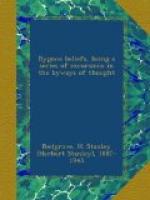“If, says THOMAS CARLYLE, . . . we . . . have led thee into the true Land of Dreams; and . . . thou lookest, even for moments, into the region of the Wonderful, and seest and feelest that thy daily life is girt with Wonder, and based on Wonder, and thy very blankets and breeches are Miracles,—then art thou profited beyond money’s worth...."[1]
[1] THOMAS CARLYLE: Sartor Resartus, bk. iii. chap. ix.
VIII
ARCHITECTURAL SYMBOLISM
I WAS once rash enough to suggest in an essay “On Symbolism in Art"[1] that “a true work of art is at once realistic, imaginative, and symbolical,” and that its aim is to make manifest the spiritual significance of the natural objects dealt with. I trust that those artists (no doubt many) who disagree with me will forgive me—a man of science—for having ventured to express any opinion whatever on the subject. But, at any rate, if the suggestions in question are accepted, then a criterion for distinguishing between art and craft is at once available; for we may say that, whilst craft aims at producing works which are physically useful, art aims at producing works which are spiritually useful. Architecture, from this point of view, is a combination of craft and art. It may, indeed, be said that the modern architecture which creates our dwelling-houses, factories, and even to a large extent our places of worship, is pure craft unmixed with art On the other hand, it might be argued that such works of architecture are not always devoid of decoration, and that “decorative art,” even though the “decorative artist” is unconscious of this fact, is based upon rules and employs symbols which have a deep significance. The truly artistic element in architecture, however, is more clearly manifest if we turn our gaze to the past. One thinks at once, of course, of the pyramids and sphinx of Egypt, and the rich and varied symbolism of design and decoration of antique structures to be found in Persia and elsewhere in the East. It is highly probable that the Egyptian pyramids were employed for astronomical purposes, and thus subserved physical utility, but it seems no less likely that their shape was suggested by a belief in some system of geometrical symbolism, and was intended to embody certain of their philosophical or religious doctrines.
[1] Published in The Occult Review for August 1912, vol. xvi. pp. 98 to 102.
The mediaeval cathedrals and churches of Europe admirably exhibit this combination of art with craft. Craft was needed to design and construct permanent buildings to protect worshippers from the inclemency of the weather; art was employed not only to decorate such buildings, but it dictated to craft many points in connection with their design. The builders of the mediaeval churches endeavoured so to construct their works that these might, as a whole and in their various parts, embody the truths, as they believed




